Do you really need to install a toilet inside your RV? I know you’re thinking of me as an old fanatic who wants to reject modern lifestyle, right? Hold your horses and let me explain. Many RVers don’t prefer to use their RV toilets when there is an alternative available and we’re going to find out why.
Some RVers install one but don’t like to use it much often, cleaning and foul smells being the unpleasant reasons behind that. Others think they are entitled to use the toilet they installed with their own money. We’re not here to prove anyone of them right or wrong.
However, if you’re interested in RV toilets, we can share our experience. There are multiple types of RV toilets you can install, depending on your needs.
Today, we’ll break down the different types of RV toilets so you can choose the one that suites you needs the best.
Different Types of RV Toilets & Their Pros and Cons
1. Macerating Flush
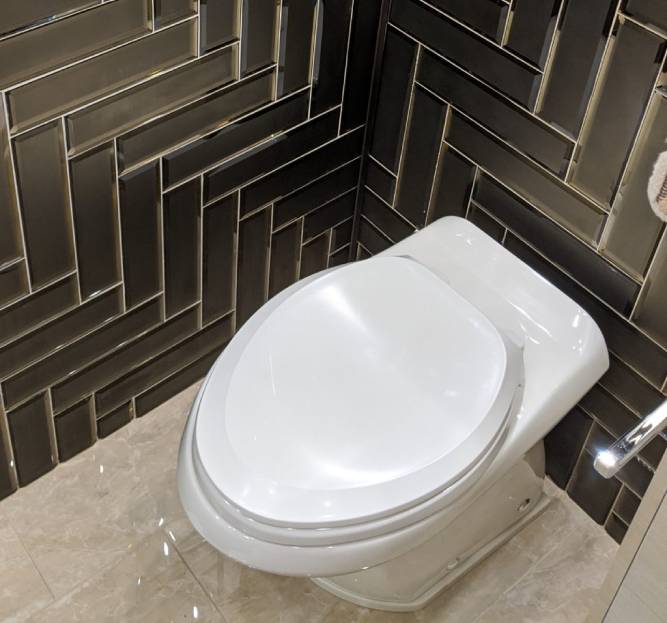
Features and Working Mechanism:
- Macerating or macerator toilets are mostly electric, but they can be also water-powered
- These toilets have motor-powered blades that thin and soften the waste before transporting it into the black tank or holding tank. The toilet and the holding tank can be positioned apart from each other due to this flushing technology
- Usually, these toilets use a small, about one-inch hose
Pros:
- It looks fancy
- It can defy gravity. You can pump the waste through a hose using electricity. So, the holding tank need not be placed just under the toilet tank. It solves space issues
- The toilet’s smaller hose makes the cleaning and dumping process simple. Keeps your toilet with less or no smell and less disaster
Cons:
- Cost is a bit higher than traditional toilets
- Waste disposing of can take more time and need a specific technique. If you are not careful enough a built-in pressure in the tube can cause a mess
- It needs regular maintenance and a lot of water while cleaning
2. Cassette Toilet
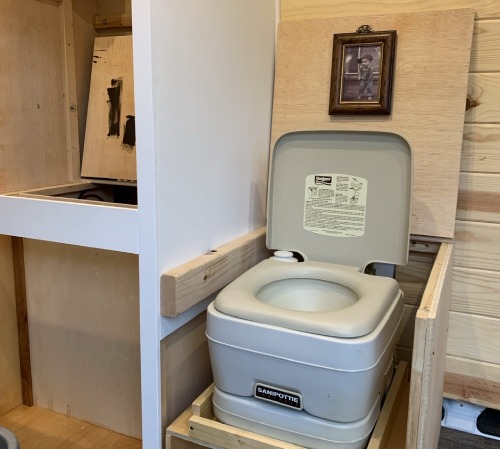
Features and Working Mechanism:
- Cassette toilets are generally, portable and pre-installed
- These are fixed in their places having black water tanks or cassettes. You can remove this cassette through an access panel on the RV’s side
- These toilets have small size tanks that roughly can hold 4.5 to 5 gallons
- You need to dump it in a bathroom or dump station
Pro:
- It is convenient for smaller spaces because of their rotating bowl
- Van owners can use these toilets because of their smaller rigs
Cons:
- Difficult to install it yourself
- Smaller tank
- You should manually dump it frequently
- Sometimes the full tanks may be heavy
- Probability to freeze during winter
- These toilets use chemicals
3. Traditional Gravity Flush
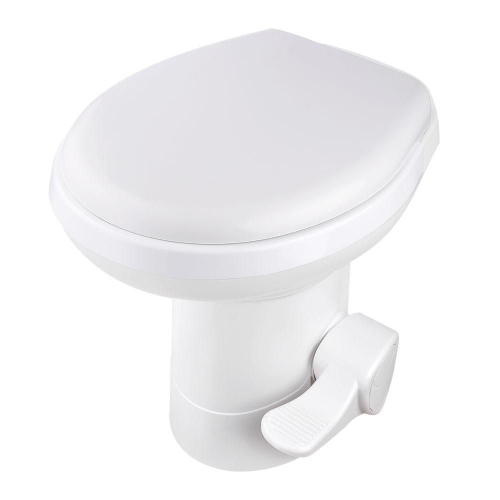
Features and Working Mechanism:
- Traditional gravity flush toilets use gravity and water to flush debris into the gray tank
- These toilets can be of different types, but generally, people like porcelain more than plastic and long bowl
- These toilets are installed over a holding tank, instead of a sewer or septic connection
- You need water function in this toilet connecting to the RV’s water tank or an external water supply
- Generally, when you flush either using an electric flush or a foot pump, the wastes of the bowl go into the black water tank that is sealed-off
- You can plumb the tank from the RV’s side and it is connected to a hose that drains the tank into a dump point
Pros:
- Easily replaceable
- Less handling because a hose empties the tank
- Tank size is large, sometimes about 40 gallons
Cons:
- Needs water and plumbing
- Freezing possibility during winter
- Uses chemicals
- You need to dump the black tank when required
- Odors can be an issue
4. Vacuum Flush
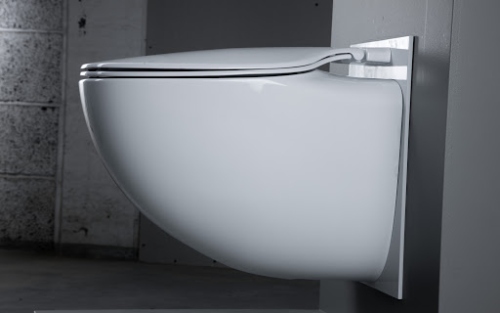
Features and Working Mechanism:
- This toilet has a vacuum flush using a macerating pump and a vacuum vessel
- The macerating pump and vacuum vessel powerfully remove the wastes in the bowl and pump to a large tank
- The toilet and holding tank are placed apart from each other like the macerator toilets
Pros:
- Flushing is more powerful because the vacuum liquefies all waste even the solid ones
- You can generally place the toilet in any convenient place of your RV
- Easily repairable
Cons:
- A bit costlier
- Less buying options
5. Portable Toilet
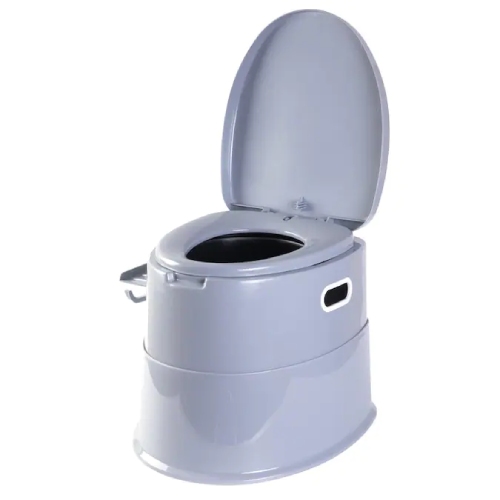
Features and Working Mechanism:
- This toilet generates raw sewage because solids are not separated from liquids
- Toilet bowls are made of lightweight plastic
- It has a small holding tank
- When the tank gets full, remove its lower tank from the upper bowl and seat, dump it into a standard disposal station or toilet
Pros:
- Totally portable
- You can place it in small places
- No actual installation needed
- The cheapest option
- Uses little water
Cons:
- The holding tank is small
- Needs frequent manual dumping
- Probability to freeze during winter
- Uses chemicals
- You will smell and see the wastes when dumping
6. Composting Toilet
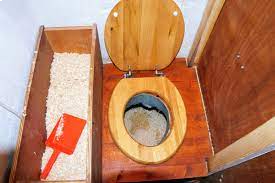
Features and Working Mechanism:
- You don’t need to use water in these toilets
- These toilets separate liquids from solids and use a composting material such as coconut coir or sphagnum peat moss to break down the solid wastes
- Composting toilets have small holding tanks
Pros:
- These toilets are ideal for places where there is limited or no water supply
- Suitable for travelers
- No black tank issues
- No smell. Often can emit a soil-like smell, using a vent fan can solve this problem
- Do not need RV toilet paper
- Never clogs
- Full composting toilets are generally lighter than full black tanks
Cons:
- Emptying compost and resetting
- You need to empty the urine tank frequently
- Unsuitable for larger families
- A bit complicated to install
- Low quality
- Poorly designed
FAQs
1. How often do you have to dump RV waste?
Ans. You can wait until at least two-thirds of the black tank is full because it enhances the flow rate. Or, you can also wait no longer than two weeks to dump the tank and fill it up with water to enhance the fill level before cleaning.
2. Can you poop in an RV toilet?
Ans. Yes. You should follow some maintenance factors:
- You should use enough water. Fill your toilet bowl before using, flush for 10 seconds, and keep little water in your toilet bowl when not using.
- There may be backups and clogs risks. But if you maintain the right measures (such as keep the black tank valve closed!), you are very unlikely to have issues. In any case, you have any problem, you can unclog the tank easily.
- Never get anything into the tank besides RV toilet tissues and human waste. Otherwise, there can be backups and clogs.
3. Can you flush toilet paper in an RV?
Ans. Yes. You can. But you need to be careful about the brand you use. Regular toilet paper can sometimes stay solid for some time after hit with water. This may cause some problems when emptying and cleaning the tank.
4. Can you replace an RV toilet with a regular toilet?
Ans. Yes. But it is not like a plug and play matter. The RV toilet brand needs to be well fixed and appropriately maintained. You should be careful or you will create a mess with the total RV toilet system.

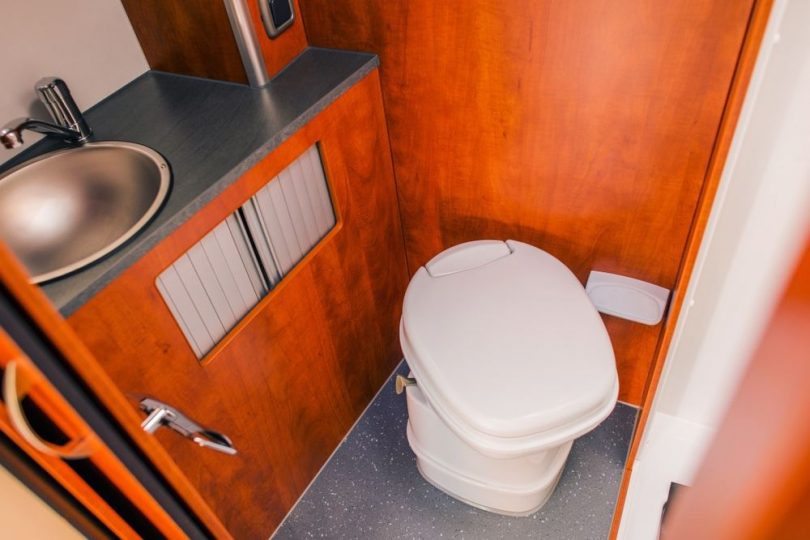






Leave a Comment